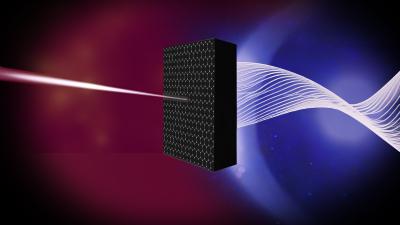Researchers from Arizona State University (ASU) have presented a design concept for enhanced saturable absorption effect based on subwavelength-thick (<1/5λ0) hybrid graphene-plasmonic metasurface structures in infrared wavelengths. Yu Yao and her research team at the ASU Center for Photonics Innovation designed a faster and more energy-efficient nanoscale laser component called the graphene-plasmonic hybrid metastructure saturable absorber, known as GPSMA.
The team's theoretical and experimental results demonstrated that, by exciting nonequilibrium carriers inside nanoscale hotspots, one could not only enhance the saturable absorption in graphene, but also reduce the saturation fluence by over 3 orders of magnitude (from ∼1 mJ/cm2 to ∼100 nJ/cm2). Their pump–probe measurement results suggested an ultrashort saturable absorption recovery time (<60 fs), which is ultimately determined by the relaxation dynamics of photoexcited carriers in graphene. They also observed pulse narrowing effects in the devices based on the autocorrelation measurement results. Such design concepts can be tailored via structure engineering to operate in broader wavelength ranges up to mid- and far- infrared spectral regions. These ultrafast low-saturation fluence saturable absorber designs can enable low-threshold, compact, self-starting mode-locked lasers, laser pulse shaping, and high-speed optical information processing.
Lasers produce narrow beams of light. When the laser’s light interacts with the surface of a material on a nanoscale, it emits a wave of light known as a plasmon, and the attributes of a given plasmon can signal information. In optic transmission, a laser pumps light at a component called a saturable absorber to generate an optical signal.
The team's recently-developed GPSMA has potential applications across communication, information processing, spectroscopy and biomedical industries. The absorber can be used to enhance the speed, efficiency and overall performance to advance data transmission, information processing, biomedical sensing and imaging technologies.
Yao’s team has been incorporating an artificially engineered metal-graphene hybrid material in their work due to its beneficial traits in optical modulation and saturable absorption.
The scientists achieved their impressive results by designing an optic antenna array that focuses light into the nanoscale gaps of the material, known as hot spots, to boost absorption. By focusing the laser on these hot spots, they observed improved performance and decreased energy usage.
“Graphene is lightweight and has a fast optical response time but has a low absorption rate in monolayer form,” Yao said. “We designed this device so that light absorption in the nanoscale hot spot can be increased by over three orders of magnitude, resulting in not only strong light absorption but also saturable absorption effects. With GPSMA, we are making a saturable absorber device that could actually reduce power consumption by almost two or three orders of magnitude.”
Their new technique could open opportunities for infrared laser spectroscopy and high-speed optical signal communication with both fiber-optic cables and satellite communication due to its speed.
“Our device can operate at record-high speed,” Yao said. “Conventional saturable absorbers can operate at nanosecond time scales, but now we’re getting to approximately 60 femtoseconds, which is over 100,000 times faster.”
GPSMA is currently operated at near-infrared wavelength on the electromagnetic spectrum. Thanks to the broad optical response of graphene, it is possible to extend its spectral coverage to longer wavelengths in the infrared spectral region, which are of great interest for molecular spectroscopy and optical communications. Yet, for the longer wavelengths, it is conventionally more difficult to achieve saturable absorbers and generate ultrashort laser pulses. The GPSMA design concept could fill this technological gap.


